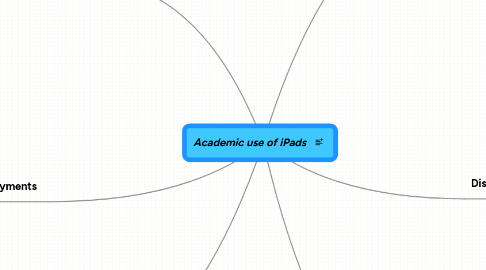
1. Campus-wide deployments
1.1. Smaller colleges/universities - 2400-5000 students - if required, cost of iPads added to Tech Fee or included in tuition
1.1.1. Seton Hill
1.1.1.1. Broad initiative with intensive faculty training and support, funded by $2M grant
1.1.1.2. AppleCare Center on campus
1.1.2. Abilene Christian University (iPhone or iPod Touch)
1.1.2.1. Faculty participation is voluntary, device is provided, minimum requirement level of one activity per week
1.1.3. George fox University
1.1.3.1. Added as an option in existing MacBook Pro program part of tuition - ended after 2010-2011 AY
1.1.4. Cumberland University
1.1.4.1. 1350 students, launching Fall 2011
1.2. Usually starts with an incoming freshman class
1.3. Training and support for faculty is key, as is sufficient bandwidth that is highly reliable
1.4. More likely to develop custom apps - Apple developers in-house or partnering with vendors to develop apps (Xanedu), provide support (SunGard)
2. Small scale deployments
2.1. Much more common
2.2. Limited to a specific cohort, program, course, or section(s) - mandatory, cost included in course fee - voluntary, usually students already own devices or purchase via a campus program - loaner devices recovered by University at the end of the program
2.2.1. NYU Stern (MBA students, voluntary)
2.2.1.1. Has since expanded to Executive MBA program, which distributes iPads
2.2.1.2. YouTube video with students
2.2.2. Marion University (Single class, cost of device is part of tuition and clearly communicated beforehand)
2.2.3. USC, Annenberg School (Loaned for duration of term)
2.2.4. Daytona Voluntary for students and faculty, university provides for faculty but some use in class is required
2.2.4.1. used primarily for eTexts, to bring down textbook costs and increase interactivity
2.2.5. Villanova nursing students, one of residence hall learning communities
2.2.6. Thunderbird executive education program
2.2.7. Cornell medical college?
2.2.8. Law schools?
2.2.9. Morningside college - nursing, music Ed, loaners
2.3. Mostly using ready-made apps from the app store or Web 2.0 sites (some of which provide free apps)
3. Implementation
3.1. Start with a pilot project with limited, well-defined scope
3.2. Support of key stakeholders is key - broad IT support and CTL collaboration nearly universal
4. Disadvantages/considerations
4.1. Current textbooks may not be available electronicallly
4.2. Some iPad apps have limited functionality comated to "full" versions
4.3. File storage has to be cloud-based (dropbox is the best option)
4.4. No printing function currently available on campus
4.5. Faculty must create an engaging experience to prevent it from becoming another distraction in class
5. Development of curriculum
5.1. Collaboration with CTL/CITL (CETL) almost universal
5.2. Providing ebooks/electronic course materials is probably the single most important component of launching an iPad-based class or program, and can also be implemented as an optional channel as a way to "get our feet wet" in providing electronic content
5.2.1. Should standardize on one reader, students shouldn't have to download 6 different apps to open all of their ebooks
5.2.2. Ideally eReader is platform independent - available for PC, Mac, iPad/iPhone, and Android platforms
5.2.3. Can provide significant cost savings to student
5.2.4. Students are more likely to have text in class with them, especially if iPads are used in class
5.2.5. Annotation is probably the most important feature, preferably with ability to share notes with peers and/or professor to share annotations.
5.2.6. Searchable, non-linear
5.2.7. Have to find current texts in electronic format, or find suitable replacements work with vendors to develop electronic coursepacks with enriched content
5.3. Live Internet search in class - students given a task of researching a subject
5.4. Classroom use of appropriate apps
5.4.1. Best practices for apps selection: free or low cost, easy to learn, cloud-based data storage if necessary
